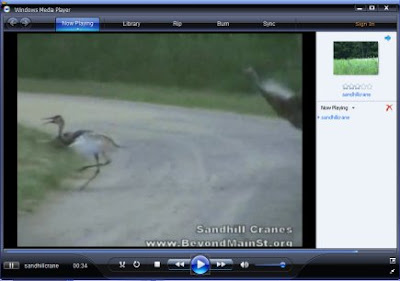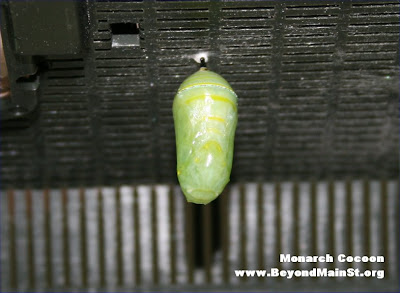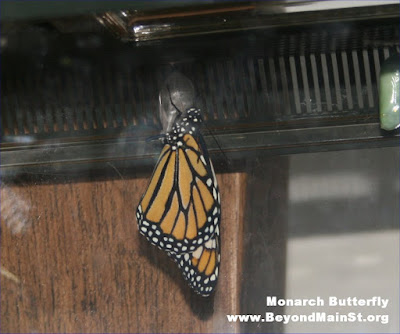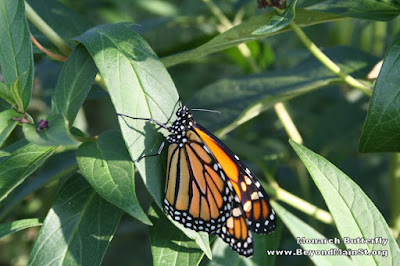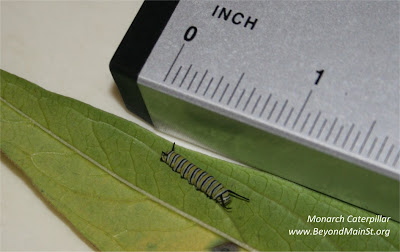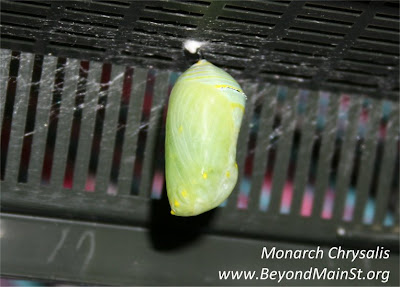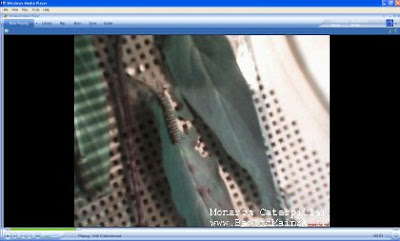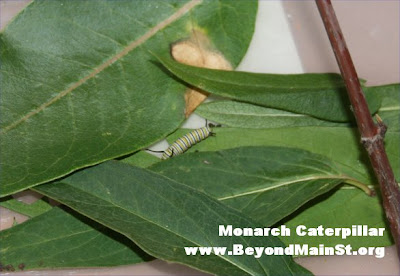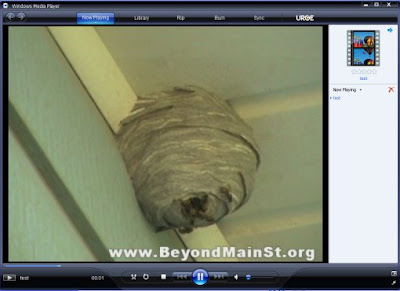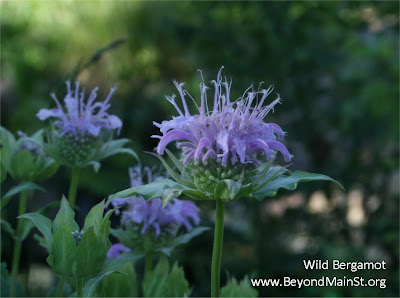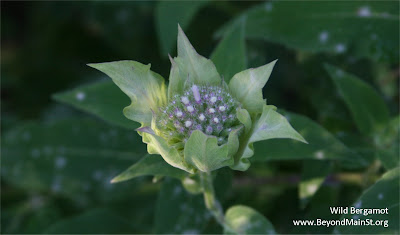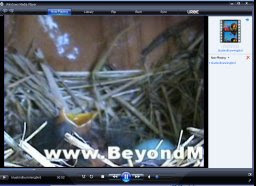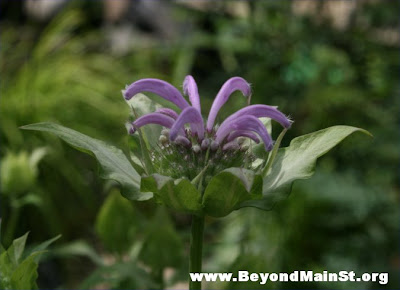Tuesday, July 31, 2007
Released Monarch #3 Monday afternoon. Picked up another caterpillar I found on the way in, making for a total of 3 caterpillars currently in the enclosure and one active cocoon.
Saw one of the Monarch Butterflies searching for nectar on a Joe Pye Weed Blossom this morning. I've also seen them picking away at the Bergamot and the Boneset.
2007 Progress:
Caterpillars: 7 (3 remaining)
Cocoons: 4 (1 remaining)
Butterflies: 3
Sunday, July 29, 2007
Time lapse video of Monarch #1 both spinning and emerging from its cocoon.
Monarch #1 was released Saturday morning, but was spotted again this afternoon feeding on the Swamp Milkweed. Various photos of Monarch #1's release:
Picked up two very small caterpillars feeding on some young Swamp Milkweed. Some development shots from Friday and this morning:
- American Toad
- Black-capped Chickadee
- Blue Jay
- Brown-headed Cowbird
- Cedar Waxwing
- Cottontail Rabbit
- Eastern Bluebird
- Eastern Chipmunk
- Goldfinch
- Grackle
- Green Frog
- Grey Catbird
- Grey Squirrel
- Grey Tree Frog
- Monarch Butterfly
- Monarch Caterpillar
- Mourning Dove
- Northern Cardinal
- Nuthatch
- Pileated Woodpecker
- Red Admiral
- Red-headed Woodpecker
- Red-winged Blackbird
- Robin
- Ruby-throated Hummingbird
- Western Chorus Frog
Natives in Bloom:
- Bergamot
- Brown-eyed Susan
- Butterfly Weed
- Common Milkweed
- Daisy Fleabane
- Dragonhead
- Harebell
- Purple Coneflower
- Swamp Milkweed
- Sweet Joe Pye Weed
- Tall Boneset
Some video of a Sandhill Crane pair we took in Carlos Avery. Amazing set of lungs on them; their call is almost prehistoric, and reminds me strongly of the Great Blue Heron or Great Egret.
Thursday, July 26, 2007
Monarch #4 spun its cocoon Wednesday morning, sometime between 6 and 7:30 AM (don't know when exactly as we were having technical difficulties.)
Monarch #2 just hatched from his cocoon this morning (given the patterns on his back, we believe #2 to be male). Unfortunately, we didn't get the hatching process on WMV, as we didn't expect it to pop yet (our research said 9-14 days; this only took 8). We will probably catch #1 hatching, however, as it spun its cocoon 24 hours after #2.
While we didn't get any shots of the hatching process, we did get some great shots of the release; here is #2 sunning his wings on a Swamp milkweed; just inches from a nectar-rich blossom.
Progress:
Caterpillars: 4 (currently 0)
Cocoons: 4 (currently 3)
Butterflies: 1
Monday, July 23, 2007
Monarch #3 spun its cocoon around 5:30 AM Saturday morning. I have a much better time lapse (at 1 frame per 6 seconds) of it I can post in a few days. He is on the right above. Unlike the others (also shown above) his gold dots have not appeared yet. Can't see much difference between #2 (on the left) and #1 (on the right), other than a slight bulge on what I can only assume is the back of #2.
Some progressive shots of Monarch Caterpillar #4. Not sure what is with his darker coloration, but it seems to have faded this morning..
A word to the wise: Monarch caterpillars poo. They poo a LOT.
Went for a drive in Carlos Avery yesterday. Saw a number of wild flowers in bloom (including the Turk's Cap Lily shown above), and a pair of Sandhills Cranes that gave us some great video; will have it posted within the week.
On an amusing note, we started out in the Forest Lake portion of Carlos Avery and somehow wound up in East Bethel.
Native Flowers in Bloom in Carlos Avery WMA:
- Bergamot
- Brown-eyed Susan
- Compass Plant
- Goldenrod
- Turk's Cap Lily
Native Flowers Blooming in Garden:
- Bergamot
- Brown-eyed Susan
- Butterfly Weed
- Common Milkweed
- Daisy Fleabane
- Dragonhead
- Harebell
- Purple Coneflower
- Spiderwort
- Swamp Milkweed
Wildlife Spotted in Carlos Avery WMA:
- Sandhill Cranes
Wildlife Spotted in Garden:
- American Toad
- Baltimore Oriole
- Black-capped Chickadee
- Blue Jay
- Brown-headed Cowbird
- Cedar Waxwing
- Cottontail Rabbit
- Eastern Bluebird
- Eastern Chipmunk
- Goldfinch
- Grackle
- Green Frog
- Grey Catbird
- Grey Squirrel
- Grey Tree Frog
- Monarch Butterfly
- Monarch Caterpillar
- Mourning Dove
- Northern Cardinal
- Nuthatch
- Pileated Woodpecker
- Red Admiral
- Red-headed Woodpecker
- Red-winged Blackbird
- Robin
- Ruby-throated Hummingbird
Friday, July 20, 2007
Video taken yesterday of Monarch#1 weaving its chrysalis in both regular time lapse (1 frame per 12 seconds) and 1/2 speed. We got a slightly better angle this time, though you can clearly see the reflection of the camera in the center of the screen. Interesting to note that both Monarchs spun their cocoons between 6:30 and 7:00 AM.
Both Monarchs are still in their cocoons; according to what I have read they will take between 9 and 14 days to emerge.
A shot of Monarch #4, our newest arrival. We got #4 off our Swamp Milkweed two days ago, and he was about 3/4 of an inch from antennae to antennae.
Progress so far:
- Caterpillars: 4
- Cocoons: 2
- Butterflies: 0
Thursday, July 19, 2007
Monarch #1 spun its chrysalis today, meaning that this one went from being just large enough to notice to spinnng its cocoon in about 9 days. Should have footage up shortly.
Wednesday, July 18, 2007
Monarch Project, Day 8
Monarch #2 spun its chrysalis around 7 AM this morning. I caught it in time lapse (1 frame every 15 seconds) and included it above in both its original (30 fps) state and 1/4 speed slow motion.
Below are photos of the caterpillar around 9 hours prior to weaving its cocoon (after it attached itself to the top of the cage with silk), and two hours after weaving its cocoon.
Monday, July 16, 2007
Monarch Project, Day 6
Some (rather clumsy) time lapse of our caterpillars (we now have three). Though there's only around eight seconds of footage here, spanned a little over two and a half hours and shows how the monarch caterpillars pause to rest between bursts of eating. I'd like to try it again for a ten hour period; may set it up tommorow.
Have learned that the Monarch's favorite host plant seems to be the Common Milkweed, as they'll pare down one of the leaves down to nothing in a few hours, whereas they'll take a day or more to graze half a Swamp milkweed leaf. None of them have touched the Butterfly weed yet.
Drake, our injured fish, is doing well. I've given him a little penicillin, he's more active, and his tail seems to be healing up.
Have noticed that the roadside Goldenrod seems to be in bloom, while that in the garden and in the neighbor's plot is still just budding.
Wildlife Spotted this Week:
- American Toad
- Baltimore Oriole
- Black-capped Chickadee
- Blue Jay
- Brown-headed Cowbird
- Cedar Waxwing
- Cottontail Rabbit
- Eastern Bluebird
- Eastern Chipmunk
- Goldfinch
- Grackle
- Green Frog
- Grey Catbird
- Grey Squirrel
- Grey Tree Frog
- Monarch Butterfly
- Monarch Caterpillar
- Mourning Dove
- Northern Cardinal
- Nuthatch
- Red Admiral
- Red-headed Woodpecker
- Robin
- Ruby-throated Hummingbird
- Western Chorus Frog
Natives in Bloom:
- Bergamot
- Butterfly Weed
- Common Milkweed
- Daisy Fleabane
- Harebell
- Purple Coneflower
- Spiderwort
- Swamp Milkweed
Thursday, July 12, 2007
In breaking pond news, we found Drake, one of our two surviving 2006 goldfish, injured in the pond. Looks like someone (possibly Nelson, the other 2006 survivor) had a go at him, tearing off some scales and basically ripping off the top half of his tail. He wasn't standing such a good chance against infection or predators (including Nelson), so we've moved him into our fishtank to give him a chance to recover (the Bala sharks and Pleco shouldn't be much of a threat to him). We've added a bit of aquarium antibiotics to the water, and hopefully he'll pull through.
We put the monarch in a spare bedroom with a 20-watt accent lamp I've timed to correspond with the amount of natural sunlight he'd be getting outside.
I haven't seen the caterpillar (not sure what gender it is) move much. Every time I come into the room it's lying inert, with rivers and bays chewed from a Swamp Milkweed leaf. It hasn't touched the Butterfly Weed (also a sort of milkweed), which leads me to believe that Monarchs have their own favorites. I've decided to throw a few forbs of Butterfly weed as well as Swamp milkweed in, and add some Common Milkweed that is growing near the curb to see what its preferences are (you'll also notice we added a small branch (you cannot tell, but it's set in there at about a 45 degree angle) to give the caterpillar something to weave its cocoon on). I have noticed that I find Monarch caterpillars on Swamp Milkweed much more often than I do on Butterfly weed.
Wednesday, July 11, 2007
Found a very small Monarch Caterpillar on one of our Swamp Milkweeds. Since a number of last year's Monarchs were picked off by wasps, we were advised by a nature center to keep these ones in a box with a steady supply of milkweed until they are ready to emerge from their cocoon.
In other news, a low-pressure front has pushed the temperatures down into the 70's. Unfortunately, there's been no rain since the weekend; bad news for area lakes, already down to record levels because of the drought.
Sunday, July 08, 2007
Video of a yellow jacket nest built under our garage eaves. These guys have been hoarding all over the Swamp Milkweed, Hummingbird, and Oriole Feeders.
Wildlife Spotted this Week:
- American Toad
- Baltimore Oriole
- Black-capped Chickadee
- Blue Jay
- Brown-headed Cowbird
- Cedar Waxwing
- Cottontail Rabbit
- Eastern Bluebird
- Eastern Chipmunk
- Goldfinch
- Grackle
- Green Frog
- Grey Catbird
- Grey Squirrel
- Grey Tree Frog
- Lightning Bug
- Monarch Butterfly
- Monarch Caterpillar
- Mourning Dove
- Northern Cardinal
- Nuthatch
- Red Admiral
- Red-headed Woodpecker
- Robin
- Ruby-throated Hummingbird
- Western Chorus Frog
Natives in Bloom:
- Bergamot
- Butterfly Weed
- Common Milkweed
- Daisy Fleabane
- Harebell
- Marsh Marigold
- Meadow Rue
- Spiderwort
- Swamp Milkweed
- 4 bluebird chicks hatched in one of our houses; making a total of 7 this year.
- We've had two Bluebird couples and one Tree Swallow couple in our two bluebird houses this year.
- Highs in the 90s and overwhelming humidity that pushes the heat index into the 100's almost all this week.
Friday, July 06, 2007
Some photos of our Wild Bergamot in various stages of bloom. Bergamot are one of my favorite Minnesota natives if for no other reason then that they are one of our most unusual. Bergamot are a member of the mint family, something that is evident if you bring a broken leaf or stem to your nose. This makes them a favorite host plant of certain species of moth caterpillar, but are generally not disturbed by deer or other mammals that suffer from indigestion.
The purple, tube-shaped petals, which grow from the center of the flower in a kind of halo, are capped with feathery tips, and are a favorite of hummingbirds, butterflies, nectar drinking moths, and (especially) bees. Their common name, Wild Bee's Balm, is very well earned. Bees seem to horde individual flowers for hours at a time, and can actually be seen sleeping on them at night, or clinging to their undersides during a rainstorm.
These plants grow incredibly well, and are extremely gregarious spreaders, though the lower leaves tend to develop fungal patches in rainy seasons. They do well in moist, well-mulched soil; ours grow to a height of around 5'.
Wednesday, July 04, 2007
Monday, July 02, 2007
A diagram showing how we plan to eventually rig the wiring of the pond. One pump (the one currently aerating and filtering) will be left to run on the current circuit, while another circuit will be added to run:
- Outlets on the deck
- The main garden lights
- The lotus spitter pump (on a timer)
- The accents (submersible lights and foggers) (on a timer)
- The waterfall pump (on a dim switch)
Sunday, July 01, 2007
Wildlife Spotted:
- American Toad
- Baltimore Oriole
- Black-capped Chickadee
- Blue Jay
- Cedar Waxwing
- Cottontail Rabbit
- Eastern Bluebird
- Eastern Chipmunk
- Goldfinch
- Grackle
- Green Frog
- Grey Catbird
- Grey Squirrel
- Grey Tree Frog
- Lightning Bug
- Monarch Butterfly
- Monarch Caterpillar
- Mourning Dove
- Northern Cardinal
- Nuthatch
- Red Admiral
- Red-headed Woodpecker
- Red-shouldered Hawk
- Red-throated Hummingbird
- Robin
- Swamp Sparrow
- Western Chorus Frog
Natives in Bloom:
- Butterfly Weed
- Common Milkweed
- Daisy Fleabane
- Harebell
- Marsh Mallow
- Meadow Rue
- Spiderwort
- Swamp Milkweed





